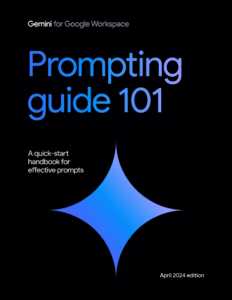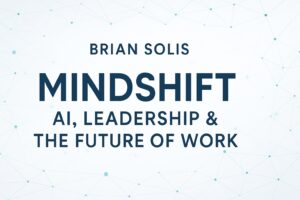AInsights: Executive-level insights on the latest in generative AI…subscribe here.
Google released a “prompt guide” for Gemini in Google Workspace. Think of it as text-based ‘co-pilot’ to help users in Google Workspace get the most out of the Gemini large language model assistant. OpenAI did something similar with ChatGPT in January 2024 (infographic here.)
The guide provides valuable tips and best practices for crafting effective prompts to get the most out of Gemini, such as using clear and concise language, providing context, using specific keywords, and breaking down complex tasks.
It’s intended to accelerate the ability to automate tasks, enhance productivity, and streamline workflows by using Gemini to generate content, summarize documents, modify tone, and more. the guide includes example prompts and refinement processes across different use cases like customer service, marketing, and project management.
The handbook identifies “four main areas to consider when writing an effective prompt,” including:
Persona: Who you are. i.e. the user.
Task: What you need Gemini to do (write, summarize, change the tone, etc.)
Context: “Provide as much context as possible.” For example, provide a written description or reference using an existing document in Google Drive (using the @-menu) to help Gemini understand the situation and desired outcome.
Format: Bullet points, talking points, specifying character count limits, etc.
Google offers additional tips to help users get the most from their collaboration with Gemini AI
Break it up: If you want Gemini for Workspace to perform several related tasks, break them into separate prompts.
Give constraints: To generate specific results, include details in your prompt such as character count limits or the number of options you’d like to generate.
Assign a role: To encourage creativity, assign a role. You can do this by starting your prompt with language like: “You are the head of a creative department for a leading advertising agency …”
Ask for feedback: In your conversation with Gemini at gemini.google.com, tell it that you’re giving it a project, include all the details you have and everything you know, and then describe the output you want. Continue the conversation by asking questions like, “What questions do you have for me that would help you provide the best output?”
Consider tone: Tailor your prompts to suit your intended audience and desired tone of the content. Ask for a specific tone such as formal, informal, technical, creative, or casual in the output.
Say it another way: Fine-tune your prompts if the results don’t meet your expectations or if you believe there’s room for improvement. An iterative process of review and refinement often yields better results.
AInsights
Prompt engineering or prompting is an art and science (please see my guide to fantastical prompting thoughts here). Whether for Gemini, Microsoft Co-Pilot, Claude, ChatGPT, Midjourney, it’s all about understanding intent, context, outcomes, and also, possibilities.
Prompting usually confines us to the world we know. But once we start exploring new horizons, stepping out of our own comfort zones, and experimenting with new voices and personas or even things, we can unlock entirely new outcomes!
Please subscribe to AInsights.
Please subscribe to my master newsletter, a Quantum of Solis.

Brian Solis | Author, Keynote Speaker, Futurist
Brian Solis is world-renowned digital analyst, anthropologist and futurist. He is also a sought-after keynote speaker and an 8x best-selling author. In his new book, Lifescale: How to live a more creative, productive and happy life, Brian tackles the struggles of living in a world rife with constant digital distractions. His previous books, X: The Experience When Business Meets Design and What’s the Future of Business explore the future of customer and user experience design and modernizing customer engagement in the four moments of truth.
Invite him to speak at your next event or bring him in to your organization to inspire colleagues, executives and boards of directors.








Leave a Reply